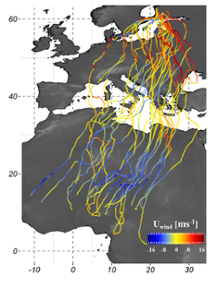Wind blows young migrant birds to all corners of Africa

Migrant birds that breed in the same area in Europe spread out across all of Africa during the northern winter. A new satellite-tracking study shows that the destination of individual birds is largely determined by the wind conditions they encounter during their first migration. The results were made available open access in the peer-reviewed journal Proceedings of the Royal Society B.
Until now, little was known about how birds learn to migrate. Many young migrant birds die on their way to Africa due to starvation, exhaustion or predation, or because they fall victim to hunters or collide with power lines and other man-made structures along the way. Wouter Vansteelant, lead author of the study, explains: 'As researchers, we take a risk by tracking young birds with expensive tracking devices. Until now, most people studied adult birds because they have a higher chance of survival. For this study, however, we decided to place satellite-tracking devices on 31 young honey buzzards that hatched from the egg in southwestern Finland.'
Of the 31 honey buzzards, 27 were able to start their first migration to Sub-Saharan Africa. Vansteelant: 'Twenty-four of these birds survived their first migration, ending up as far west as Mali and as far east as the Congo. The most western bird was located more than 3300 km from the most eastern bird.'
The research team found that birds' final destinations were further west or east depending on the wind conditions they encountered along the way. 'We also saw that some individuals deviated from their average course to cross barriers. A quarter of the honey buzzards, for example, avoided the Baltic Sea by flying over land through Scandinavia, and therefore ended up further west than other birds, and further west than expected from the wind conditions they encountered alone.'
That young honey buzzards drift with the winds shows that their wintering destination is not predetermined genetically and that chance weather events decide where each individual will return to winter for the rest of its life. Vansteelant says, 'We suspect this strategy is very common among migrant birds, and probably developed at a time when plenty of suitable wintering habitats were available across the whole breadth of tropical Africa.'
It remains to be seen if that strategy will remain viable under ongoing habitat destruction due to intensification of agriculture, deforestation and climate change. 'If we want to conserve European breeding populations of migrant landbirds, we should focus on measures that will ensure preservation of suitable landscapes for these birds across many developing Sub-Saharan countries rather than the creation of a couple of scattered reserves.'
More information: W. M. G. Vansteelant et al. Wind conditions and geography shape the first outbound migration of juvenile honey buzzards and their distribution across sub-Saharan Africa, Proceedings of the Royal Society B: Biological Sciences (2017). DOI: 10.1098/rspb.2017.0387
Journal information: Proceedings of the Royal Society B
Provided by University of Amsterdam



















